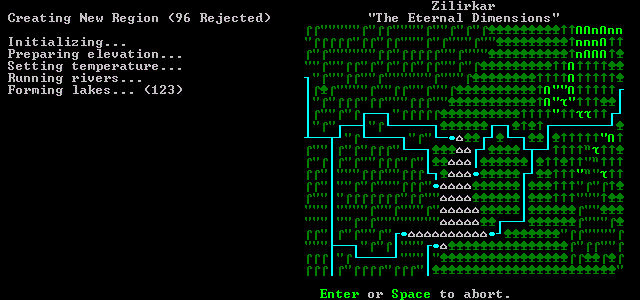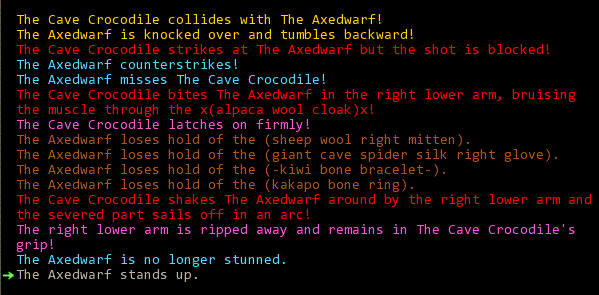
Slaves to Armok: God of Blood Chapter II: Dwarf Fortress, or just Dwarf Fortress for short, is one of my most influential games, and yet, also so strikingly different and deep than any other I’ve played. Is it the insanely detailed simulation model, the gory (literally) details, obtuse user interface and lack of graphics or the fact that the game is 100% free? No, I believe it’s the immersion and imagination stimulation factor that really gets the brain flowing and gets you into the randomly generated, yet personalized, world you create in the Dwarf Fortress universe. Dwarf Fortress is a game of intrigue and wonder, where you guide your seven dwarves to sustenance, adventure, peril, and hard-but-rewarding labors. Dig your rooms, dabble in wondrous industries, hone the skills of your dwarf warriors, amass wealth, forge allies and defend the mountain homes from wretched filth! If you’ve played a Sim City before and felt this to be a detailed model of city building, you’re in for a real treat with Dwarf Fortress.
Before your dwarves embark and strike the earth, you must first define the planet which you will be using. I’ve only done the basic world generation, but even that is fairly involved. You’ll specify things like the world size, age, average mineral quantities, and number of legendary beasts. Once you’ve inputted your parameters, you’ll literally see the world form up, climates change, and civilizations rise and fall. In the end, you will have civilizations that have a rich, generated history that can be reviewed including heroes, important battles, legendary artifacts, and revered gods, all randomly generated, often with funny names such as Kogask ConfusedAttic’s masterwork engraving titled, “The Wheat of Boulders.” These generated names all follow a dwarven language with important bits translated into English for those illiterate in the language. Often you get goofy gibberish, not unlike the technobabble explanations you hear from Star Trek franchises.
 Generating the world Zilirkar. Things are more legible if you use a tile-set, but slightly less dwarfy.
Generating the world Zilirkar. Things are more legible if you use a tile-set, but slightly less dwarfy.
If you’re happy with your world, then it’s time to seek out a suitable embark site. You may have a big world; thankfully, the game has a search tool for finding a site, with parameters such as temperature, vegetation, amount of soil, minerals, etc. In a callback to Oregon Trail, you can then choose your embark load-out, including tweaking your starting dwarfs skills, how many barrels of mole-man blood to bring, and how many yaks you’ll be traveling with. I strongly recommend bringing a few female egg-laying creatures. Eggs will make a great supplement to your food. But enough of all of this; let’s get to the actual fortress part.
After you arrive, your seven dwarves and a wagon full of your supplies will be sitting out on the land. You’ll need to find a suitable place to strike the earth! But, you can’t assign individual dwarfs to do tasks like WarCraft. Instead, you define jobs by designating tiles of land to dig, or designating a workshop to be built at a location and its building material. Then, a dwarf who is available will do the task, but only after he’s good and ready, dagnabbit! Your dwarf knows there’s work to be done, but eating, sleeping, swigging booze, and beard management are almost always more important than any of your designated labors. The important thing to remember is that you’re not directly controlling a dwarf, but merely queuing up tasks for someone to run on the terrain (gathering plants, digging, wood chopping), or queuing up construction tasks in your workshops (cooking, brewing, leather works, etc.). Thankfully, you can assign a manager that lets you type out a command, and it will get tasked out to the appropriate workshop whenever the manager gets a chance to review your plans.
The game’s model is excruciatingly detailed. Let’s take a look at cooking. You should start your journey out with some plants you can use for cooking, and some seeds. In your kitchen, your cook will combine plants ingredients into something like a stew, biscuits, or a roast. Someone will haul these prepared meals to a prepared meal stockpile. When your dwarves get hungry, they’ll eat. They’ll eat anything rather than die, but each dwarf will have preferences. Maybe he really likes tiger meat and whip vines, but detests turkey spleen. His actions will reflect these likes and dislikes for really any object in the game, and have good or bad moods based on this.
Anyways, back to the cook. The plant seeds will be extracted by the cook and the seeds will go to another bin. If you’ve built a farm plot to grow the crop associated with these seeds, then a farmer will eventually plant the seeds, and then the grown plant will be harvested when it’s ready. The plant can then be used in a new meal, or used at the still to brew some nice dwarven rum to quench their thirsts. But dwarves aren’t herbivores; they like to eat meat. But meat doesn’t just fall from the sky into your laps. Well, you can always shoot down an eagle or osprey…and in fact, yes, we should do this. Dwarves with the hunting skill will gear up with a crossbow and bolts that they either brought with them to your site, or you constructed from a bowyer and bolts from either a carpentry shop (wood), craftdwarf shop (bone), or metalcraft shop (metal), and begin the hunt. Assuming the hunter doesn’t get mauled by the zombie penguin or whatever you’re hunting, he’ll return the kill to your butcher shop where he’ll be dissected into meat and prepared organs which can then be cooked. Bones can be used for crafting armor, bolts, and crafts, and the tallow can be used to make soap for your healthcare industry. So as you can see, we use the whole buffalo. It’s a brave new world out there, and your first fort will be a leap of faith. Fortunately, there’ s a guide to help get you started, which I strongly suggest you use to follow along.
 Some dwarves (and apparently a number of geese) gathering in my dining hall for a meal. On the right, we have a still and kitchen for brewing and cooking, and also a butcher shop and tannery for chopping up corpses and tanning raw hides into leather.
Some dwarves (and apparently a number of geese) gathering in my dining hall for a meal. On the right, we have a still and kitchen for brewing and cooking, and also a butcher shop and tannery for chopping up corpses and tanning raw hides into leather.
Now compare this food industry to, say, WarCraft. In WarCraft, you simply purchase a farm with gold that you acquired at the mine. There’s no concept of raw materials (except wood, but the farm doesn’t cost wood). Everything just magically works. There’s nothing really wrong with it, but it’s simply too high-level to be realistic and has been done in many games for decades. Dwarf Fortress is about as close to reality as we’ll probably ever get in a video game (assuming reality consists of dwarves, elves, goblins, and reanimated unicorn skeletons).
So as you begin to understand the different labors, so will your dwarves. They will gain proficiency in the skills they use, and either spend less time doing the task, or yield higher-quality products which are of a greater value. You can even specify a workshop to only allow people with certain skill ranges to use the shop. As your dwarves labor and eat, they will eventually produce offspring, a process that actually follows rules of genetics, inheriting traits from their parents. The expectant mothers will drop trou right in the middle of hauling stone or whatever task they’re doing, and birth your little bundle of joy. Be sure to protect the young, as your enemies will come to snatch the little buggers. If this or other tragic events happen (such as the deaths of close friends or loved ones), dwarves can enter a state of melancholy and insanity. They may start refusing to take orders or even kill other members of the fort. This can cause a shame spiral where, eventually, everyone in the fort is either so dead or stricken with grief that there’s nothing you can do. So, while you may have fended off many goblins in a recent siege, internal distress may be your undoing.
But, you’re not just going to sit there and let the enemy walk all over you, right? Dwarf Fortress has a very detailed military system where you can define squads with areas to train, store gear, and sleep, and give monthly orders to go on patrol, defend areas, and so forth. There’s a pretty steep learning curve here, but there are many tutorials and friendly folk in the game’s communities that are always willing to lend a hand. Beyond the military, why not channel out a vast trench? Fill it with water or pump it with magma from the planet’s warm center? How about a long drawbridge into your fort? Force your enemies to walk on the bridge and draw the bridge up while they’re on it, flinging them God-knows-where. Personally, I took much satisfaction for trading the elven merchants for one of their grizzly bears. The grizzly became a valued sentry after my beast master trained him for war. He did OK at fending off the undead that were advancing into my fort, but after he fell, he was later reanimated by the necromancer and the fun-loving, cuddly grizzly I trained became an agent of evil; he had to be destroyed. Undead are tough because, as the different limbs are severed, a necromancer can reanimate nearly any small body part; it quickly becomes an exponential problem.
 Battle Log showing an Axedwarf who underestimated a Cave Crocodile, and lost an arm because of it. As you can see, biology is quite detailed here, where individual organs, skin, muscle, tendons, etc. are all a part of the simulation.
Battle Log showing an Axedwarf who underestimated a Cave Crocodile, and lost an arm because of it. As you can see, biology is quite detailed here, where individual organs, skin, muscle, tendons, etc. are all a part of the simulation.
While there are organized civilizations on the surface world, if you continue to dig down many Z-levels, you will eventually break into vast underground caverns filled with exotic flora and fauna, many of them deadly. Among them are the Forgotten Beasts, randomly generated superfiends that will often give you a run for your money dwarf bucks. The fort I’ve pictured in this article was subdued by a mighty feathered flying leech. He had boiling extract breath that seemed to cause the dwarves’ skin to burn off and then caused them to bleed out. I did get a few arrow strikes in, but he was too tough for me, and nearly everyone was killed. I abandoned the fortress, and survivors left the lands. I started a nearby fort the next year, and actually had some of the survivors immigrate to my new fort. It was really cool to see a rich history continue with the survivors.
 A different beast I encountered.
A different beast I encountered.
 Supply depot of wood, bones and shells, gems, and stone. I positioned stockpiles 1 Z-level below the associated workshops so the crafters did not have to travel far to get raw supplies. Path efficiency makes for a well-oiled fortress.
Supply depot of wood, bones and shells, gems, and stone. I positioned stockpiles 1 Z-level below the associated workshops so the crafters did not have to travel far to get raw supplies. Path efficiency makes for a well-oiled fortress.
Everything in the review has thus far been about Fortress Mode. There is also an Adventure Mode, similar to Rogue or Final Fantasy where you set forth boldly into the world with a generated character and seek out quests. I have not been too successful with this mode, and find myself getting attacked by Boogeymen at night or ambushed by Goblins on the way to my first quest. I feel that there’s a lot going on here and I haven’t even scratched the surface, but I do know that there’s a new update to Dwarf Fortress on the horizon that will greatly expand the details of generated towns and fortresses to include the other races and be more real and detailed. Typically people play for Fortress Mode, but this may change when the advancements come to Adventure Mode.
Dwarf Fortress is not without bugs. But unlike Bethesda titles that cause game crashes and broken quests, most of Dwarf Fortress‘ bugs are simply adorable. The game is constantly being worked on and the development blog always let you know how things are progressing. DF is also a great water cooler game because you’ll always have something new to talk about. No two fortresses are ever the same; you’ll always have a unique experience.
It certainly has a steep learning curve, and the user interfaces leaves much to be desired. That being said, given some time and experience, you will get used to it. It’s good to get a feel for the bare ASCII graphics, but I recommend using a tile set and the Lazy Newb Pack to get started. You’ll revel in the great detail and immersive gameplay in Dwarf Fortress; it is truly a work of art.

Dawww… I wonder why developers don’t use this random awesomeness more frequently, many games’d have a higher replay value if the experience was different with every playthrough.
My guess is that it doesn’t fit their business model. Why make a genuinely randomized, varied experience if you can just make DLC packs that cost money?
Other games have tried it, like Skyrim’s system for randomized events. They’re all pretty basic thoguh. “Some of the Jarl’s men left this”, and it’s a quest to go kill some thugs in a cave somewhere. I guess it’s better than nothing.